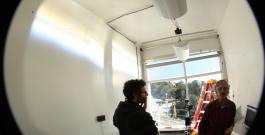Daylighting Systems
The challenge of daylighting buildings has been how to achieve an efficient redistribution of flux within a building with a source that is both variable in intensity and position: the sun and the sky. Solving this problem will reduce or eliminate the need for electric lighting during the day. Energy savings are achieved through daylight-controllable lighting systems, but interior shades can reduce daylighting potential, and glare poses significant challenges. If a low-cost technology can be devised for widespread applications, daylighting has the potential to reduce U.S. energy use by 1.0–1.5 quads (1.0-1.5 x 1015 BTUs). LBNL researchers are working to develop new materials and systems for daylighting buildings in collaboration with industry.




